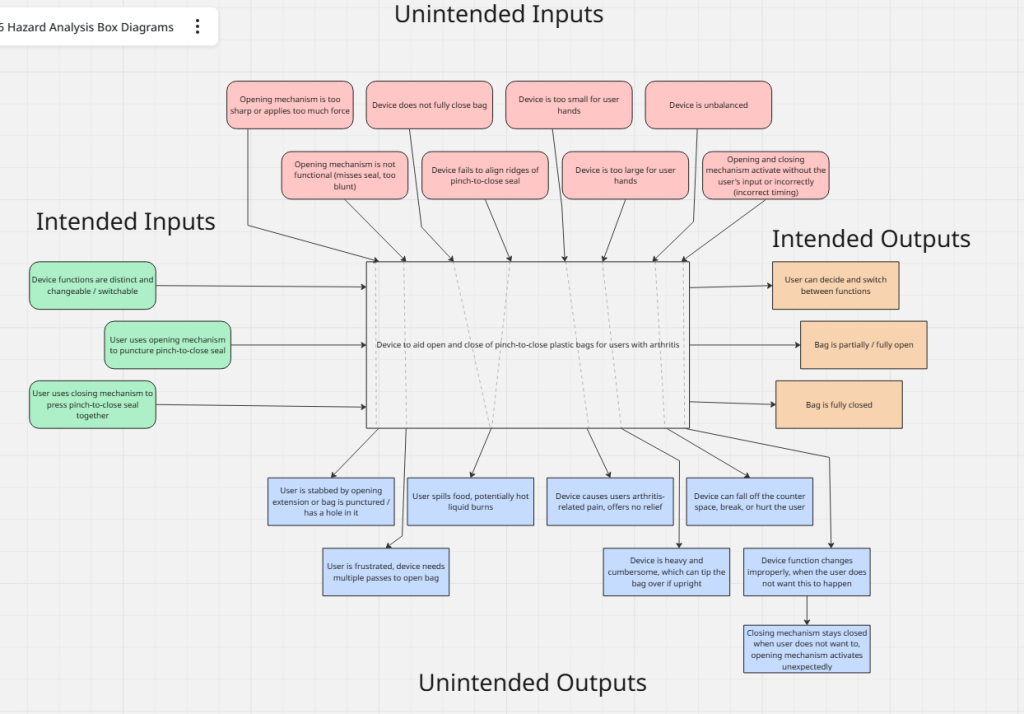Intended Use for the Device
- Used to open and close pinch-to-close bags, as defined in the traceability matrix
- Users are people with arthritis (for any reason- old age, injury, disease), who struggle to open pinch-to-close bags
- Device to be used in kitchen settings, preparing meals, or maybe in the grocery store
Preliminary Inputs and Outputs
Preliminary hazard analysis box diagram:

Intended Input 1: Device functions are distinct and changeable CAUSES Intended Output 1: User can decide and switch between functions
Intended Input 2: User uses opening mechanism to puncture through pinch-to-close seal CAUSES Intended Output 2: Bag is partially / fully open
Intended Input 3: User uses closing mechanism to press pinch-to-close mechanism back together CAUSES Intended Output 3: Bag is fully closed, no leakage of liquid or food
Unintended Input 1: Opening mechanism is too sharp or has too much force CAUSES Unintended Output 1: User is stabbed by opening extension or plastic bag is punctured / has a hole in it
Unintended Input 2: Opening mechanism is not functional or too blunt CAUSES Unintended Output 2: User is frustrated, and device needs multiple passes to open bag
Unintended Input 3: Device does not fully close bag AND Unintended Input 4: Device cannot align the ridges of pinch-to-close mechanism CAUSE Unintended Output 3+4: User spills food, potentially hot liquid burns them
Unintended Input 5: Device is too small CAUSES Unintended Output 5: Device still causes users arthritis-related pain
Unintended Input 6: Device is too large CAUSES Unintended Output 6: Device is heavy enough to be cumbersome, or tip bag over when upright
Unintended Input 7: Device is wobbly on its own CAUSES Unintended Output 7: Device falls off counter space
Unintended Input 8: Open or close mechanism activates without user’s input or incorrectly CAUSES Unintended Output 8: Device function changes improperly
Fault Tree Analysis
The Fault Tree Analysis is used to represent the relationships between a negative outcome (at the top of the tree) and the underlying causes. This takes on a top-down approach that starts with the negative outcome. The analysis is meant to find the various ways the negative outcome can occur, which informs the hazards and risks within the FMEA.
The first fault tree analysis was done with the top consequence when the device fails to open the bag. Overall, this would mean the device does not work and would cause the user more joint pain and frustration. See the structure below:

Here, the main consequence could be due to a. the opening tool failing to extend at the correct time, b. the extension tool not aligned with the seal on the bag, or c. the extension tool is not sharp enough to open the seal. Then, the extension tool could be jammed, and something is preventing it from extending or the hinge mechanism is broken. This is further broken down into if food gets stuck within the hinge mechanism or if other 3D printed parts cause the extension to jam. Ultimately, this could be due to if there are small fragments of 3D printed plastic that come loose from the main body. Next, if the extension is not aligned with the bag seal, this could be due to if the user is unable to align the bag and device, or if the device fails to align with the ridges. Lastly, the extension could be too blunt due to our design of the extending opening tool or if there was a misprint during the printing process. Overall, this concern relates back to one of the main user needs / intended uses for the device, which is to ensure that the pinch-to-close seal on the plastic bag is opened using the device.
The second fault tree analysis was done with the consequence when the device cannot stand on its own (not in relation to a bag). See below:

Here, we were concerned if the device were to fall off of a countertop and break or land on the user’s foot. If the device breaks, it could send fragments of plastic or metal around the floor, which is a hazard to the user. For this, we considered a. if the device was not level on the bottom and b. if the device was not equally distributed in weight. For the first, the device could be not level if the design was initially not level or if the device had a misprint. Next, the device could be improperly weight distributed if the device is too top-heavy, and the center of mass is too high. Alternatively, this could be due to how the weight changes when the closing mechanism is hinged open and closed. To address this, we must ensure that the body of the design is not impacted and can balanced when the closing mechanism is in use. Overall, this concern is to decrease the harm the device could cause when not in use, the device’s portability and aesthetics.
Lastly, a final fault tree analysis was done with the consequence if the device fails to fully close the plastic bag. See below:

The last major concern that we had was in the case where the device could not close the bag fully. This was an already established hazard, as we thought about if the contents of the bag were hot or heavy. In this case, food spilling out could cause the user greater harm in burns.
Here a major concern was if the device were able to align the ridges of the pinch-to-close bags. In this case, there would be slits in the device to align the ridges when the closing mechanism is active. However, this mechanism may fail if the ridges are aligned too high or low for the clamp, or if the ridges are misaligned. Furthermore, another hazard would be if the device could not fully close the bag, or if the closing mechanism was not continuously providing sufficient force to close. From this, the device could fail if the motion was not continuous, if the clamp did not apply enough force, or if there were ‘gaps’ within the clamping process.
For further information, please see the attached Miro board with all three Fault Tree Analysis Diagrams.
FMEA (Failure Mode Effect Analysis)
The FMEA table as below depicts our preliminary failure analysis as the design stands currently.

Not shown here are the risk control efforts, the risk-to-benefit analysis, and any additional comments. Our hazard functions were derived from the fault tree analysis and our traceability matrix. For example, the device unable to open the bag, unable to close the bag fully, and stand on its own is addressed above the fault tree analysis. Additional hazards that we are concerned about is if the opening mechanism is too sharp, if the device size is not correct, or if parts of the 3D print detach from the device.
For example, if the device is too large for the user, the weight of the device could be cumbersome. This would put additional strain on the user and cause more joint pain. If the device is cumbersome, the user could drop the device or the plastic bag, which could fall on their foot or other people. This becomes especially hazardous of hot foods are/were in the plastic bag, as this could cause burns and lead the user to seek medical help. To address the risk, we would need to perform iterative designing to adjust to the average user’s hand size.
For further information and the complete FMEA form, please see this Google Sheet Link:
